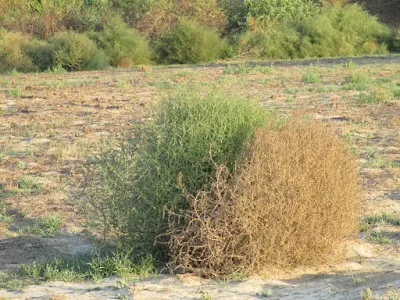 |
| The rolling tumbleweeds |
Tumbleweeds are known for their relentless spread and eerie, wandering presence across the American West. While often seen in movies as a symbol of desolate landscapes, these seemingly harmless plants are actually among the fastest-spreading invasive species in North America. Here, we dive into the history, unique biology, and surprising environmental impact of tumbleweeds—the “rolling legends” that have made their mark on both landscapes and culture.
 |
| A half-drying tumbleweed |
What Are Tumbleweeds? Nature's Rolling Seed Dispersers
Scientifically known as Salsola tragus (Russian thistle), tumbleweeds are annual plants that start as a compact, green shrub. As they mature, their stems dry out and weaken, allowing them to break off and roll freely with the wind, spreading seeds as they go. This movement is more than just iconic imagery—it's an efficient strategy that allows each tumbleweed plant to disperse up to 250,000 seeds, ensuring rapid propagation over large distances.
 |
| A moving tumbleweed |
The Surprising Origins of Tumbleweeds in North America
Interestingly, tumbleweeds are not native to North America. They are believed to have arrived in the late 19th century via Russian immigrants, whose flaxseed shipments accidentally carried tumbleweed seeds into South Dakota. Their adaptability and rapid spread allowed them to quickly become a dominant feature of the American West, particularly thriving in dry, open areas where they face minimal competition from other plants.
Why Do Tumbleweeds Roll? The Mechanics of Seed Dispersal
The rolling behavior of tumbleweeds is their evolutionary answer to seed dispersal. Once the plant matures, it dries and detaches at the base, allowing it to roll with the wind across vast distances. With each roll, it drops seeds, establishing new plants wherever the seeds settle. This enables tumbleweeds to cover up to several miles in a single journey, increasing their spread and further solidifying their status as one of the most successful invasive plants.
 |
| A tumbleweed hold by hand |
While their rolling nature is fascinating, tumbleweeds pose significant ecological challenges. They quickly outcompete native plants, disrupting local ecosystems and damaging soil health. Their dry, brittle nature also creates substantial fire risks in dry climates, where they can amass and ignite easily, fueling fast-moving fires. In agricultural and urban areas, tumbleweeds can clog irrigation systems, block roads, and even damage infrastructure.
Interesting Facts About Tumbleweeds
- Not Just One Species: "Tumbleweed" encompasses several species, including Salsola tragus and Kochia scoparia, both known for their invasive tendencies.
- Fire Hazards: When dried, tumbleweeds are highly flammable and can create severe fire hazards in regions they populate.
- Highly Adaptive: Tumbleweeds can grow in poor soils, minimal water, and extreme conditions, making them resilient and challenging to eradicate.
- Creative Uses: From holiday decorations to alternative biofuel sources, people have found unique ways to repurpose these otherwise problematic plants.
 |
| Tumbleweed flowers |
In pop culture, tumbleweeds symbolize isolation and the American frontier, often featured in films as they roll across abandoned ghost towns. However, beyond their cultural image, they’re a reminder of how non-native species can dramatically alter landscapes and pose unexpected challenges.
Tackling the Tumbleweed Problem
Effective tumbleweed management is essential in areas affected by their rapid spread. Strategies include physical removal, early detection, and controlled burning. In farming and ranching regions, herbicides are sometimes applied to prevent their regrowth, while creating natural barriers can help prevent their spread into critical areas.

